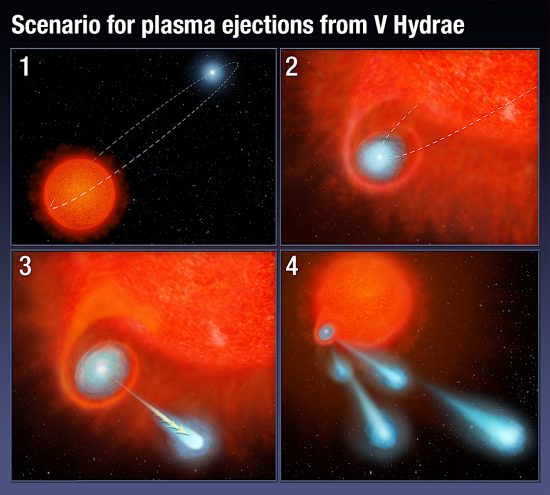
Credit: NASA, ESA, and A. Feild (STScI)
Oct 19, 2016
Electric stars produce electrical effects.
According to a recent press release, the Hubble Space Telescope detected hot “blobs of gas” ejected from a dying star. The “plasma balls” erupt about once every 8.5 years and have been doing so for approximately 400 years.
The star, V Hydrae, is what astronomers call a red giant. Red giants are conventionally thought to be old stars in the last stages of life. In an Electric Universe, a star is assumed to be electromagnetically bound and externally powered. A red giant star has no photosphere. Rather than anode tufts radiating at high temperatures, V Hydrae’s chromosphere has expanded so that it can gather electrons from surrounding space. With no photosphere, a star cannot regulate a constant output, so its energetic discharges are variable.
Red giants are cool, sometimes no more than 200-1000 Celsius, so molecular gas and dust are prevalent around them. The material acts like an electrode in the star’s electrical circuit, so its gases and dust are positively charged. This means that there is an outflow from V Hydrae corresponding to the hot discharge, or solar wind, that the Sun emits. Such phenomena are commonly called “mass ejections”, allowing the consensus to ignore any electrical aspects.
How do cool temperatures create such an extreme radiative output? Acceleration of charge away from a positively charged star contradicts mechanical mass ejection and can only be due to an electric field. As input voltage to a star varies, its amperage varies, so its output varies. In some red giants, plasmas collect in a toroid around their discharge axes.
In previous Picture of the Day articles, it was noted that many structures in the Universe are active energy sources—some galaxies eject charged matter out from their poles, or leave long braided tails extending for thousands of light-years. Smaller formations (stars and planetary nebulae) are hourglass shapes composed of tightly bunched filaments. Such filamentary structures are known as Birkeland currents.
Electric Star theory resolves many “inexplicable” ideas that arise from a lack of knowledge about plasma and electric fields in space. Instead of kinetic effects, V Hydrae is powered by electricity. The electric power density in dusty plasma is greatest along the axes of Birkeland current filaments. Once the flux density reaches a critical point, double layers form along the filaments. A double layer can accelerate charged plasma to high velocities while simultaneously compressing it, releasing all the stored energy in a double layer explosion.
As Nobel laureate, Hannes Alfvén wrote:
“When current density surpasses critcal [sic] value an exploding DL is produced in which most of the circuit energy is released. This causes a solar flare (Alfvén and Carlqvist, 1967; Carlqvist, 1969). Hénoux (1985) has recently given an interesting study of solar flares and concludes that a current disruption by DL’S is an appealing explanation of solar flares. Under certain circumstances the electromagnetic pressure of the current loop may produce a motor which gives rise to [a] rising prominence.”
V Hydrae’s plasma balls are caused by double layer explosions and acceleration.
Stephen Smith












